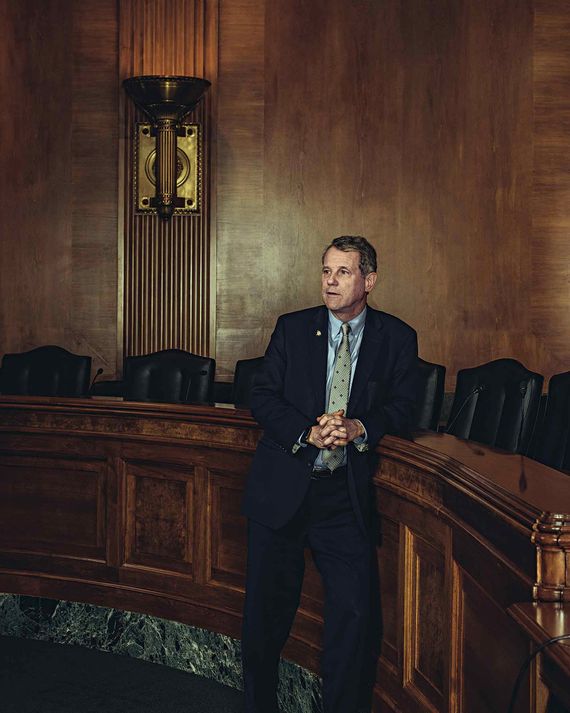
Settling into a small meeting room in the seventh-floor office he inherited from Barack Obama in 2009, U.S. senator Sherrod Brown of Ohio clasps his hands, creases his brow, and doesn’t exactly deny that this is a slightly strange, and very busy, time for him — the unpolished, suddenly great, gritty hope among all the bright, shiny things that make up the overflowing 2020 Democratic presidential field. “It is unexpected. I mean, we all go into elections thinking we’re going to win,” he says, “and I guess I did. And I thought it’d be a nice celebration, then go back to work.”
In case you haven’t noticed: There’s a bit of a messy civil war going on in the Democratic Party, and one of the more boisterous battles is between those who think it should move hard left in 2020, to chase a progressive base, or to the center, to woo the working-class voters whose support Donald Trump rode to the presidency in 2016. This fight, and all of the party’s disagreements, have an identity aspect, like everything in American politics: Should Democrats lean further into being the party of women and minorities or focus more on the white voters who turned out last time? But Brown seems, to himself and a growing group of fans, at least, like he could square the circle. He’s the rare surviving old-school midwestern Democrat who thrives among the kinds of workers who voted for Trump, and he’s among the most progressive senators — he wins in big cities. He was just reelected again in Ohio, after all, where most Democrats not named Sherrod lost on November 6. That night, he called his campaign a “blueprint for America in 2020.”
Brown insists he really didn’t think of himself as a national contender until “literally Election Night. You know … I mean — every politician who can put a complete sentence together, from a big state, somebody has said to them at some point, ‘You oughta think about running.’ But it never occurred to me to actually do it until … sort of … the response to Election Night,” he says, flashing his knowing, just-a-bit-lopsided grin. “Connie [Schultz, his wife] and I were pretty overwhelmed by the number of people that called us or emailed us or went online, or whatever.”
That morning, less than a month after they started considering it, Schultz — a Pulitzer Prize–winning columnist and a popular voice in Ohio — called Brown to tell him the Toledo Blade’s new editorial had pushed him for president while dubbing him “Mr. Uncharisma.” She tweeted that he “howled with laughter” at the name, but when I bring it up a few hours later, Brown just tilts his head in response. Almost every national article written about Brown describes him as “rumpled,” which is kind of true, and calls his voice a “gravelly rasp” (he does sound like he’s constantly growling).
Of course, his look is part of his long-cultivated reputation as a populist anti-hero, and, in the 2020 context, it’s related to his bet that the party may be looking for that kind of not-too-slick, relatable face — a less outsider-y Bernie Sanders and less corporate Joe Biden. Or at least a slightly younger one. Not that Brown is, technically, any kind of outsider: He’s 66, he’s been in Washington for 25 years and in elected office for 43. He was an under-the-radar finalist to be Hillary Clinton’s running mate.
But he’s still learning how to float himself for the presidency, and he’s still getting used to the attention. I ask him how it feels to have just about every political journalist turn his or her attention his way all of a sudden and he shakes his head slightly, sounding dismayed: “It’s hardly everyone!” he protests.
Brown is relatively unknown nationally, compared with other possible contenders like Elizabeth Warren and Kamala Harris, but he does check a lot of “authenticity” boxes. His gray hair is always called “messy” (it is), and when he got a haircut shortly after we spoke, Schultz explained on Twitter that they’d agreed to cut it shorter but not comb it. His suits really are locally made, it’s true he named his dog Franklin after FDR, he still despises the term Rust Belt, and he always wears a lapel pin — given to him years ago by a steelworker — depicting a canary (think coal mine) to symbolize workers’ progress and the work remaining. And he has a long progressive history — as a congressman, he voted against the Defense of Marriage Act in 1996 and opposed the Iraq War, though he hasn’t always sided with the Democrats’ leftmost wing. He backs a more incremental health-care plan than Sanders’s Medicare for All. Squint and it even looks like he agrees with a small sliver of Trump’s agenda, too: He wrote a 2004 book called Myths of Free Trade.
Still, he and the president don’t remotely see themselves as any kind of allies. One day earlier, GM announced it would shut down a plant — and with it, 1,400 jobs — and Trump essentially blamed Brown, Ohio’s only statewide-elected Democrat. “The president said that?” he asks, momentarily looking variously sad, hurt, angry, and bewildered. “He actually said that?!” He steadies for half a moment, then revs up. Brown had tried convincing Trump to pressure GM against closing the plant this summer, he tells me, accelerating; plus the president had promised locals that jobs were coming back, plus Trump’s tax law had given companies like GM a huge break, plus “This phony populism of Trump! He talks a good game and delivers nothing on these jobs!” Early in Brown’s career, he spent a lot of time hanging out at the steelworkers’ union hall in Mansfield. In 2018, he campaigned on a message about the “dignity of work” while trying to reclaim the word populist from Trumpists. Lately, he’s become a fixture on TV, increasing his national profile while nudging Trump on trade and railing against GM.
Brown’s pro-worker platform would probably be built on some of the policies he has specifically outlined in the past two years, including raising the federal minimum wage and strengthening labor laws to bolster unions and broaden collective-bargaining rights. He’s also proposed cracking down on corporations whose workers are forced to rely on federal aid programs because of their low pay. When David Brooks wrote in the Times last month, “It’s not jobs, jobs, jobs anymore. It’s relationships, relationships, relationships,” Brown replied in a letter to the editor, “Actually, it’s wages, wages, wages. And respecting the dignity of work.”
The industrial Midwest will likely be central to the 2020 race, and Brown is waiting to see if anyone else can beat Trump in the region using a message of fighting for workers. When I ask if he’s ever heard of any other Democrat doing that satisfactorily, he says quickly, “Oh, sure. Yeah. Probably … Harry Truman did … Not to make comparisons. I don’t want to go there.” He doesn’t pause, though he looks pained. “I think that … plenty of successful and unsuccessful … I think [Hubert] Humphrey did.” No one who’s served in the past four decades, in other words.
Brown thinks he can teach his party to do it. “You talk to [voters] about the dignity of work: ‘You may disagree with me on guns or disagree with me on marriage equality’ — and I’ve got an F from the NRA and been for marriage equality for 20 years. But you do all this without compromising on civil rights and LGBTQ rights and workers’ rights and women’s rights, and you do it without caving to Wall Street or the drug companies or Trump.” However, he’s not much sunnier about his party’s current standing in Ohio, which Trump won in 2016 after Obama carried it twice. Even Brown’s own six-point win there last month was smaller than projected. (His rivals went personal, bringing up allegations of physical abuse from his 1986 divorce, though his ex-wife now actively supports him.) Some Democrats are even making noises about abandoning Ohio altogether.
“It was pretty disappointing, because I don’t like the direction my state’s going. I mean, from Harrisburg to Des Moines, with the exception of the Columbus and Chicago suburbs, you see the demographics changing; you see my state getting more conservative, getting harder to win,” Brown says, standing up to head to the Capitol for a vote. “But I still thought that Republican corruption in state government, and the fact that our state is growing so much slower than the national average, and the fact that our infant-mortality rate is so high, opioid-addiction rates are so high, and the scandal in state government — I really thought we were going to win some of these races.” He sounds disappointed for the first time all afternoon. His smile disappears. He pauses by a SENATORS ONLY elevator and jams the down button with his thumb, then looks back, slowing down for just a moment to underscore what, exactly, changed.
“Election Night was … ummm … All my friends lost.”
*This article appears in the December 10, 2018, issue of New York Magazine. Subscribe Now!






























